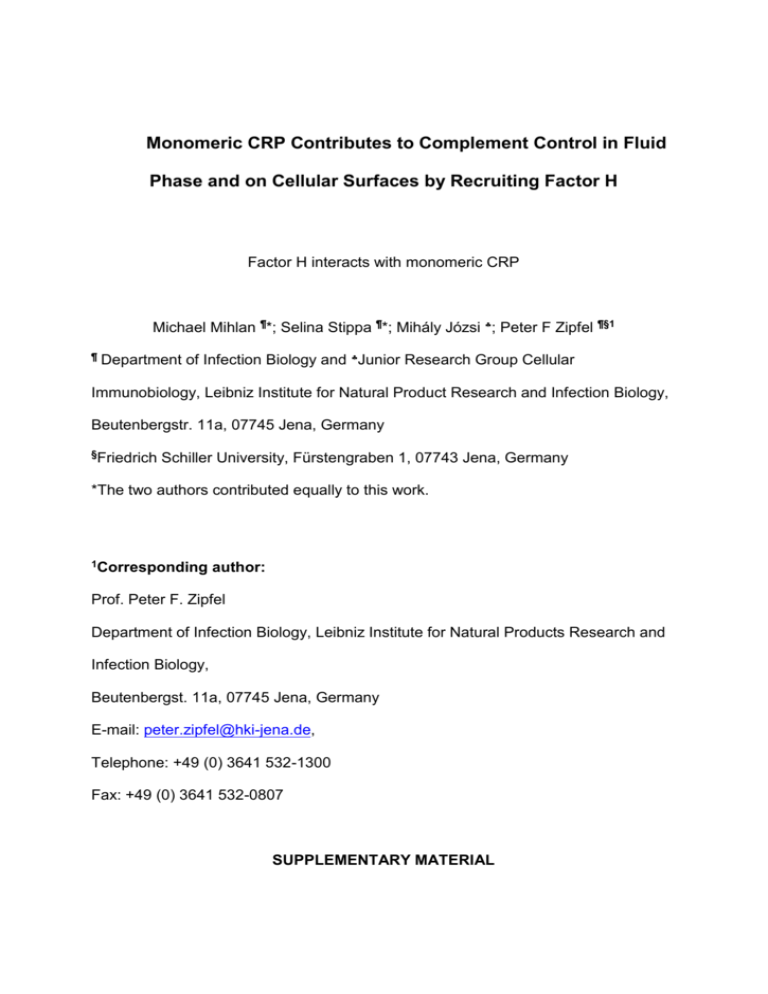Supplementary Information (doc 57K)
advertisement

Monomeric CRP Contributes to Complement Control in Fluid Phase and on Cellular Surfaces by Recruiting Factor H Factor H interacts with monomeric CRP Michael Mihlan ¶*; Selina Stippa ¶*; Mihály Józsi ; Peter F Zipfel ¶§1 ¶ Department of Infection Biology and Junior Research Group Cellular Immunobiology, Leibniz Institute for Natural Product Research and Infection Biology, Beutenbergstr. 11a, 07745 Jena, Germany §Friedrich Schiller University, Fürstengraben 1, 07743 Jena, Germany *The two authors contributed equally to this work. 1Corresponding author: Prof. Peter F. Zipfel Department of Infection Biology, Leibniz Institute for Natural Products Research and Infection Biology, Beutenbergst. 11a, 07745 Jena, Germany E-mail: peter.zipfel@hki-jena.de, Telephone: +49 (0) 3641 532-1300 Fax: +49 (0) 3641 532-0807 SUPPLEMENTARY MATERIAL Supplemental Material and Methods. Chromatography. pCRP and mCRP were analyzed by high-performance liquid chromatography (HPLC) using a Superdex®200-HR 10/30 column (GE Healthcare, GB) which was equilibrated at 4°C in 10 mM PBS (pH 7.4) (SR1). The column was calibrated with the size standards aldolase (158 kDa) and chymotrypsin A (25 kDa) (GE Healthcare). pCRP and mCRP (30 µg each) were separately loaded onto the column at a flow rate of 0.5 ml/min and during elution the absorbance was monitored at 280 nm. Fractions were collected and the presence of pCRP and mCRP was analyzed by ELISA, using mAbs specific for pCRP (Antibodies Online, Aachen, Germany) or mCRP (Sigma-Aldrich). The specific mAbs were immobilized in buffer A (15 mM Na2CO3, 34 mM NaHCO3, 3 mM NaN3, pH 9.6) onto Maxisorp microtiter-plates (Nunc). After blocking and extensive washing, various pCRP and mCRP containing fractions were added and bound CRP isoforms were detected with a polyclonal rabbit CRP antiserum in combination with a horseradish peroxidase-conjugated anti-rabbit IgG secondary antibody. Effect of ionic strength and heparin on Factor H:mCRP interaction The effect of the ionic strength on the Factor H:mCRP interaction was analyzed by ELISA. Wells were coated with Factor H or SCRs 15-20 (10 µg/ml each) and after blocking, mCRP (10 µg/ml) was added in TC-buffer in the presence of increasing NaCl concentrations. After washing with TC-Tween, mCRP binding was analyzed as described in material and methods. The inhibitory effect of heparin on Factor H:pCRP/mCRP interaction was analyzed by ELISA. Wells were coated with Factor H, or the Factor H deletion construct SCRs 15-20, and either pCRP or mCRP were added in the presence of increasing concentrations of heparin in TC-buffer. CRP binding was detected as described in material and methods. C3b binding of Factor H : CRP complex C3b (5 µg/ml) and BSA (5 µg/ml) used as a negative control in DPBS were coated to Maxisorp ELISA plates. After blocking with blocking buffer (Applichem), the two CRP isoforms, Factor H or a combination of both were added in buffer containing calcium in the fluid phase (10 µg/ml). Bound CRP was detected with goat CRP antiserum and Factor H using goat Factor H antiserum (Merck, Germany) followed by peroxidaseconjugated rabbit anti-goat IgG. Dose dependent binding of Factor H and CRP to necrotic cells. Binding of Factor H and of the two CRP isoforms to necrotic cells was analyzed by flow cytometry. HUVEC cells (~ 1*106 cells) were incubated with increasing concentrations of either Factor H, or pCRP, or mCRP (30 µg/ml, 60 µg/ml) in TC buffer supplemented with 1% bovine serum albumine (BSA) by gentle shaking for 20 min at 37 °C. The washing steps, and all subsequent reactions were performed in TC buffer in the presence of Ca2+. After extensive washing, CRP or Factor H antiserum (Merck), were added to the cells for 20 min at 4 °C. Following further incubation with a secondary FITC conjugated antibody (Dako) the cells were analyzed by flow cytometry. Cofactor activity of Factor H : mCRP complex Cofactor activity of Factor H bound to mCRP was measured by Western Blot (A) and ELISA (B). mCRP was coated to the surface of a microtiter plate (NUNC), and Factor H (5 – 20 µg/ml) was added. After extensive washing with DPBS, C3b (15 µg/ml) and Factor I (5 µg/ml) were incubated for 1 h at 37° C. C3b degradation products were directly detected either using mouse iC3b antibody (Quidel) in ELISA or upon separation of the reactions by SDS-PAGE, transferred to a membrane and using polyclonal goat C3 antiserum (Merck). Complement activation level on apoptotic particles and cells Apoptotic cells were incubated in Factor H depleted, complement active human plasma (10 %) for 15 minutes at 30°C in Hepes buffer (20mM Hepes, 140mM NaCl; 2mM CaCl2; 1mM MgCl2). C9 deposition was measured by flow cytometry either on apoptotic particles or on late apoptotic cells using rabbit anti C9 serum (Comptech) and anti rabbit-Alexa647. Regulation of C9 deposition at the cell surface Apoptotic HUVEC cells were incubated with either mCRP, Factor H (30 µg/ml each) or a combination of both proteins in TC-BSA buffer. After washing, cells were incubated in Factor H depleted, complement active human plasma (10 %) for 15 minutes at 30°C in Hepes buffer (20mM Hepes, 140mM NaCl; 2mM CaCl2; 1mM MgCl2). To determine background staining, Factor H depleted plasma was also incubated in buffer containing 20 mM EDTA. C9 deposition was measured either on apoptotic particles or on late apoptotic cells using rabbit C9 antiserum (Comptech) and anti rabbit-Alexa647. MFI values were normalized to the signal obtained with untreated apoptotic particles / cells, incubated with Factor H depleted plasma. Supplementary Results Supplementary Figure 1: Generation of mCRP. mCRP was generated by treating recombinant pCRP with urea and by EDTA chelation1. Both mCRP and pCRP were separated by SDS-PAGE and visualized by silver staining (Supplementary Figure 1A). Untreated pCRP appeared as a smear at around 40 kDa, indicating dissociation of the pentameric complex upon SDS treatment and gel electrophoresis (Supplementary Figure 1A, lane 1). The urea/EDTA treated CRP appeared as a single, sharp band of approximately 22 kDa which corresponds to the size of one single mCRP unit (Supplementary Figure 1A, lane 2). Furthermore, mCRP and pCRP were analyzed by size exclusion chromatography. pCRP eluted with a retention time of 28 min (peak I), whereas the urea/EDTA treated CRP eluted later after 33 min (peak II) (Supplementary Figure 1B). Fractions, representing peak I and II were analyzed by ELISA using isoform specific mAbs. The faster eluting peak I reacted with a mAb specific for pCRP, but not with a mAb specific for mCRP (Supplementary Figure 1C, black columns). In contrast, the slower eluting fraction (peak II) reacted with the mCRP specific, but not with the pCRP specific mAb (Supplementary Figure 1C, stippled columns). Thus, based on the mobility, the retention time by gel chromatography, and the reactivity with specific mAb, we conclude that mCRP, which differs from pCRP in size and reactivity, was generated. Supplementary Figure 2. Dose dependent binding of Factor H and CRP to necrotic cells. Binding of Factor H (panel I), pCRP (panel II) and mCRP (panel III) to necrotic HUVEC cells was assayed using 30 and 60 ug of the indicated protein by flow cytometry. The binding of the three proteins was dependent on the protein concentration. The mean fluorescence intensity and standard deviation (MFI & SD) for Factor H, pCRP and mCRP binding to necrotic cells are shown in Supplementary Table 1. Unspecific binding of antisera alone to necrotic HUVEC is shown as control. Supplementary Table 1 Factor H PCRP mCRP 30 µg/ml 15436 23550 22424 60 µg/ml 19415 29919 33839 control 12114 13322 13312 Supplementary titles and legends to figures Supplementary Figure 1: Characterization of mCRP and pCRP. (A) pCRP and mCRP, generated from pCRP by urea treatment and chelatation with EDTA, were separated by SDS-PAGE and identified by silver staining. (B) Both CRP isoforms were separated by size exclusion chromatography. The elution profile (A280nm) of pCRP (peak I, dotted line; retention time 28 min) and mCRP (peak II, solid line, retention time 33 min) is shown. Arrows indicate peak elution of mass calibration standards with 158 kDa and 25 kDa. Fractions, representing the peaks at 28 min (I) and 33 min (II) were collected and analyzed by ELISA using CRP isoform specific mAbs. (C) Fraction obtained from peak I react with mAb specific to pCRP but not to mCRP. Peak II is bound by mAb to mCRP but not by mAb to pCRP. Supplementary Figure 2: Dose dependent binding of Factor H and CRP to necrotic cells. Binding of Factor H, pCRP and mCRP to necrotic HUVEC cells was analyzed by flow cytometry using specific antisera. The thick lines (grey 30 µg/ml, black 60 µg/ml) show binding of the proteins and the thin gray line show the antiserum control. Binding of Factor H (I), pCRP (II) and mCRP (III) is dose dependent to necrotic HUVEC cells. The data are representative for three independent experiments. Supplementary Figure 3: CRP isoforms do not affect Factor H binding to C3b. C3b was immobilized to a microtiter plate and binding of CRP isoforms, Factor H, as well as of Factor H : CRP complexes was assayed in buffer containing Ca2+. After extensive washing, bound CRP and Factor H was detected with either polyclonal CRP antiserum or polyclonal Factor H antiserum. pCRP and mCRP did not bind to C3b. Factor H bound to C3b (column 3). Neither pCRP nor mCRP affect Factor H binding to immobilized C3b (columns 4 and 5). Supplementary Figure 4: Factor H : mCRP interaction is non ionic and is affected by heparin. (A)The effect of ionic strength on mCRP binding to immobilized Factor H (◊) and Factor H deletion construct SCRs 15-20 (▲) was analyzed by increasing concentrations of NaCl. At a NaCl concentration of 560 mM, binding is slightly reduced. Background signal of buffer without protein (●) is not affected by increasing NaCl concentration. The data represents mean values + SD of three independent experiments. (B, C) Binding of CRP to immobilized Factor H and Factor H deletion fragment SCRs 15-20 was assayed in the presence of increasing heparin concentrations. Ranges from 10 µg/ml up to 500 µg/ml of heparin partially inhibited binding of Factor H deletion constructs to pCRP. (C) Binding of mCRP to Factor H and Factor H deletion constructs was reduced significantly (p<0.05; p<0.01). The analysis was performed in the presence of Ca2+. The figure shows mean values + SD of data from three independent experiments. Supplementary Figure 5: Factor H bound to mCRP maintains complement regulatory activity. mCRP was immobilized to a microtiter plate and increasing concentrations of Factor H were bound. After extensive washing, C3b and Factor I were added. C3b cleavage products were detected either by Western Blot (A) or ELISA (B). (A) Polyclonal C3 antiserum was used for detection. Factor H displayed cofactor activity for Factor I, as demonstrated by appearance of the cleavage fragments α’ 68, α’ 46, and α’ 43 (lanes 2 to 5). mCRP served as negative control for uncleaved C3b (lane 1). The results show a representative experiment of three. (B) C3b degradation was detected using mouse iC3b antibody. Factor H retains its cofactor activity for Factor I mediated C3b cleavage when bound to mCRP (lanes 2 to 5). Factor H added with increasing concentrations enhance iC3b generation. Immobilized mCRP served as negative control (lane 1). Supplementary Figure 6: Complement activation on the surface of apoptotic particles is higher than on late apoptotic cells. Apoptotic particles (black columns) and late apoptotic cells (white columns) were incubated in Factor H depleted, complement active human plasma and after 15 minutes C9 complexes on the surface were quantitated by flow cytometry. C9 deposition is about 15 times stronger on the surface of late apoptotic cells than on apoptotic particles. Mean MFI values and standard deviation of six independent experiments are shown. Supplementary Figure 7: Factor prevent H C9 and Factor deposition H:mCRP on the complexes surface of apoptotic particles and late apoptotic cells. C9 deposition was determined on the surface of apoptotic particles (A) or late apoptotic cells (B) as a marker for terminal complement pathway activation. Apoptotic particles or cells were incubated in Factor H depleted, complement active human plasma for 15 minutes and after extensive washing C9 deposition was determined by flow cytometry (Panel A and B, column 2). When complement activation was inhibited by EDTA, background levels were obtained (columns 3). Treatment of the particles with either mCRP or Factor H alone reduced C9 levels on the surface (Panel A, columns 4 and 5). Particles treated with a combination of mCRP and Factor H show significantly lower C9 complexes at their surface (column 6). (B) Similar results were obtained for late apoptotic cells. However, the decrease in C9 deposition was not as pronounced. This indicates that on surfaces with high levels of complement activation like on late apoptotic cells, the protective action of attached Factor H is minor and overridden by the strong complement activation (Supplementary Figure 6). The data show MFI mean values of six independent experiments. Data were normalized to C9 deposition of untreated particles or cells. Supplementary References S1. Potempa LA, Siegel JN, Fiedel BA, Potempa RT, Gewurz H. Expression, detection and assay of a neoantigen (Neo-CRP) associated with a free, human C-reactive protein subunit. Mol Immunol 1987; 24(5): 531-41.





